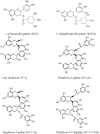Effect of extraction conditions on measured total polyphenol contents and antioxidant and antibacterial activities of black tea
- PMID: 17851405
- PMCID: PMC6149426
- DOI: 10.3390/12030484
Effect of extraction conditions on measured total polyphenol contents and antioxidant and antibacterial activities of black tea
Abstract
Black tea was extracted for 2, 8 and 18 h with absolute acetone, N,N-dimethyl-formamide (DMF), ethanol and methanol and their 50% aqueous solutions. The extracts were screened for total polyphenol contents, antioxidant and antibacterial activities. The polyphenol content of the extracts was found to be in the range of 0.44-114.01 mg gallic acid equivalents (GAE)/g dry weight tea, depending on the solvent used and the length of the extraction process. In general, aqueous acetone or DMF extracts displayed the highest polyphenol contents and antioxidant activity, while absolute acetone was the least efficient solvent. Antioxidant activities of tea extracts tested using the reducing power and 2,2-diphenyl-1-picryhydrazyl (DPPH) radical methods ranged from 0.09 to 1.18 and from 2.60 to 95.42 %, respectively, depending on the extraction conditions and the antioxidant activities correlated well with the polyphenol concentrations. Aqueous solvent black tea extracts also possessed antibacterial activity, depending on the solvent used and bacterial species tested. Staphylococcus aureus was found to be the most sensitive to all tea extracts, except for the methanol extract. Tea extracts were not effective against Y. enterocolitica, L. monocytogenes and E. coli O157:H7.
References
-
- Gupta S., Saha B., Giri A.K. Comparative antimutagenic and anticlastogenic effects of green tea and black tea: a review. Mutat. Res. 2002;512:37–65. - PubMed
-
- Halder B., Pramanick S., Mukhopadhyoy S., Giri A.K. Inhibition of benzo[a]pyrene induced mutagenicity and genotoxicity multiple test systems. Food Chem. Toxicol. 2005;43:591–597. - PubMed
-
- Han C. Screening of anticarcinogenic ingredients in tea polyphenols. Cancer Lett. 1997;114:153–158. - PubMed
-
- Chung K.T., Lu Z., Chou M.W. Mechanism of inhibition of tannic acid and related compounds on the growth of intestinal bacteria. Food Chem. Toxicol. 1998;36:1053–1060. - PubMed
Publication types
MeSH terms
Substances
LinkOut - more resources
Full Text Sources
Medical


